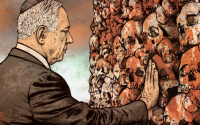8 October 2005Gardiner Harris
A plan developed by the Bush administration to deal with any possible outbreak of pandemicflu shows that the United States is woefully unprepared for what could become the worst disaster in the nation's history.
A draft of the final plan, which has been years in the making and is expected to be released later this month, says a large outbreak that began in Asia would be likely, because of modern travel patterns, to reach the United States within "a few months or even weeks."
The 381-page plan calls for quarantine and travel restrictions but concedes that such measures "are unlikely to delay introduction of pandemic disease into the U.S. by more than a month or two."
The plan's 10 supplements suggest specific ways that local and state governments should prepare now for an eventual pandemic by, for instance, drafting legal documents that would justify quarantines. Written by health officials, the plan does not yet address responses by the military or other governmental departments.
The plan outlines a worst-case scenario in which more than 1.9 million Americans would die and 8.5 million would be hospitalized with costs exceeding $450 billion.
It also calls for a domestic vaccine production capacity of 600 million doses within six months, more than 10 times the present capacity.
On Friday, President Bush invited the leaders of the nation's top six vaccine producers to the White House to cajole them into increasing their domestic vaccine capacity, and the flu plan demonstrates just how monumental a task these companies have before them.
In the wake of Hurricane Katrina, the Bush administration's efforts to plan for a possible pandemic flu have become controversial, with many Democrats in Congress charging that the administration has not done enough. Many have pointed to the lengthy writing process of the flu plan as evidence of this.
But while the administration's flu plan, officially called the Pandemic Influenza Strategic Plan, closely outlines how the Health and Human Services Department may react during a pandemic, it skirts many essential decisions, like how the military may be deployed.
"The real shortcoming of the plan is that it doesn't say who's in charge," said a top health official who provided the plan to The Times. "We don't want to have a FEMA-like response, where it's not clear who's running what."
Still, the official, who asked for anonymity because the plan was not supposed to be distributed, called the plan a "major milestone" that was "very comprehensive" and sorely needed.
The draft provided to The Times is dated Sept. 30, and is stamped "for internal H.H.S. use only." The plan asks government officials to clear it by Oct. 6.
Christina Pearson, a spokeswoman for Health and Human Services Secretary Michael O. Leavitt, responded, "We recognize that the H.H.S. plan will be a foundation for a governmentwide plan, and that process has already begun."
Ms. Pearson said that Mr. Leavitt has already had one-on-one meetings with other cabinet secretaries to begin the coordination process across the federal government. But she emphasized that the plan given to The Times was a draft and had not been finalized.
Mr. Leavitt is leaving Saturday for a 10-day trip to at least four Asian nations, where he will meet with health and agriculture officials to discuss planning for a pandemic flu. He said at a briefing on Friday that the administration's flu plan would be officially released soon. He was not aware at the briefing that The Times had a copy of the plan. And he emphasized that the chances that the virus now killing birds in Asia would become a human pandemic were unknown but probably low. A pandemic is global epidemic of disease.
"It may be a while longer, but pandemic will likely occur in the future," he said.
And he said that flu planning would soon become a national exercise.
"It will require school districts to have a plan on how they will deal with school opening and closing," he said. "It will require the mayor to have a plan on whether or not they're going to ask the theaters not to have a movie."
"Over the next couple of months you will see a great deal of activity asking metropolitan areas, 'Are you ready?' If not, here is what must be done," he said.
A key point of contention if an epidemic strikes is who will get vaccines first. The administration's plan suggests a triage distribution for these essential medicines. Groups like the military, National Guard and other national security groups were left out.
Beyond the military, however, the first in line for essential medicines are workers in plants making the vaccines and drugs as well as medical personnel working directly with those sickened by the disease. Next are the elderly and severely ill. Then come pregnant women, transplant and AIDS patients, and parents of infants. Finally, the police, firefighters and government leaders are next.
The plan also calls for a national stockpile of 133 million courses of antiviral treatment. The administration has bought 4.3 million.
The plan details the responsibilities of top health officials in each phase of a spreading pandemic, starting with planning and surveillance efforts and ending with coordination with the Department of Defense.
Much of the plan is a dry recitation of the science and basic bureaucratic steps that must be followed as a virus races around the globe. But the plan has the feel of a television movie-of-the-week when it describes a possible pandemic situation that begins, "In April of the current year, an outbreak of severe respiratory illness is identified in a small village."
"Twenty patients have required hospitalization at the local provincial hospital, five of whom have died from pneumonia and respiratory failure," the plan states.
The flu spreads and begins to make headlines around the world. Top health officials swing into action and isolate the new viral strain in laboratories. The scientists discover that "the vaccine developed previously for the avian strain will only provide partial protection," the plan states.
In June, federal health officials find airline passengers infected with the virus "arriving in four major U.S. cities," the plan states. By July, small outbreaks are being reported around the nation. It spreads.
As the outbreak peaks, about a quarter of workers stay home because they are sick or afraid of becoming sick. Hospitals are overwhelmed.
"Social unrest occurs," the plan states. "Public anxiety heightens mistrust of government, diminishing compliance with public health advisories." Mortuaries and funeral homes are overwhelmed.
Presently, an avian virus has decimated chicken and other bird flocks in 11 countries. It has infected more than 100 people, about 60 of whom have died, but nearly all of these victims got the disease directly from birds. An epidemic is only possible when a virus begins to pass easily among humans.






